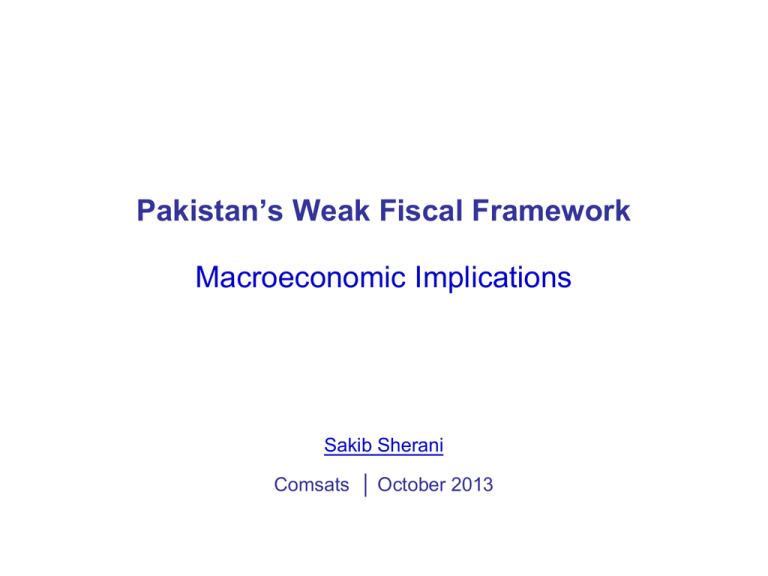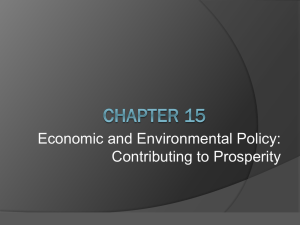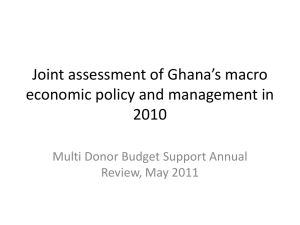Macroeconomic Implications Fiscal Framework (Oct 2013)
advertisement

Pakistan’s Weak Fiscal Framework Macroeconomic Implications Sakib Sherani Comsats │ October 2013 Fiscal Framework Marked by structural rigidities: Fiscal Framework Marked by structural rigidities: • Revenue Fiscal Framework Marked by structural rigidities: • Revenue – Narrow tax base Fiscal Framework Marked by structural rigidities: • Revenue – Narrow tax base • Reliance on indirect taxes Fiscal Framework Marked by structural rigidities: • Revenue – Narrow tax base • Reliance on indirect taxes – Low tax buoyancy and elasticity Fiscal Framework Marked by structural rigidities: • Revenue – Narrow tax base • Reliance on indirect taxes – Low tax buoyancy and elasticity – Tax assignment & provincial fiscal effort Fiscal Framework Marked by structural rigidities: • Revenue – Narrow tax base • Reliance on indirect taxes – Low tax buoyancy and elasticity – Tax assignment & provincial fiscal effort – Governance issues & exemptions regime Fiscal Framework Marked by structural rigidities: • Expenditure Fiscal Framework Marked by structural rigidities: • Expenditure – Generous fiscal transfers regime (NFC Award) Fiscal Framework Marked by structural rigidities: • Expenditure – Generous fiscal transfers regime (NFC Award) – Debt servicing & defense-related Fiscal Framework Marked by structural rigidities: • Expenditure – Generous fiscal transfers regime (NFC Award) – Debt servicing & defense-related – Untargeted subsidies Fiscal Framework Marked by structural rigidities: • Expenditure – Generous fiscal transfers regime (NFC Award) – Debt servicing & defense-related – Untargeted subsidies • Consumption-oriented rather than Investment-driven Pakistan’s Tax Culture 14 Pakistan’s Tax Culture 180 million people 15 Pakistan’s Tax Culture 180 million people 3.7 million tax registered 16 Pakistan’s Tax Culture 180 million people 3.7 million tax registered 711,000 file return 17 Pakistan’s Tax Culture 180 million people 3.7 million tax registered 0.7 million file return (0.9 mn salaried) 18 Pakistan’s Tax Culture 180 million people 3.7 million tax registered 0.7 million file return (0.9 mn salaried) X% actually pay 19 Pakistan’s Tax Culture 180 million people 3.7 million tax registered 0.7 million file return (0.9 mn salaried) X% actually pay Z% pay honestly 20 Pakistan’s Tax Culture • 776,000 people in 3 cities with assets, property, >1 car, bank accounts, foreign travel ≠ not on tax register – Expanded to 3.2 million in 2012 (FBR/NADRA) • 61% of parliament reportedly filed “nil” taxable income in last filed income tax return 21 Tax vs GDP Growth Growth in Nom. GDP vs FBR Tax Collection 35 GDP 30 Tax Collection(FBR) 25 20 15 10 5 0 FY-97 FY-98 FY-99 FY-00 FY-01 FY-02 FY-03 FY-04 FY-05 FY-06 FY-07 FY-08 FY-09 FY-10 22 Context Stagnant Tax revenues …. Tax to GDP (%) Source: FBR 23 Context Stagnant Tax revenues …. Tax to GDP (%) Avg = 9.2% Source: FBR 24 Object Classification Principal repayment of loans Interest payment Operating expenses Grants, Subsidies & Loan write offs Employees related Expenses Civil Military Investment Physical assets Civil Works Repairs & Maint. Transfers Total Expenditure 2012-13 (B) 7,562 928 884 % of Total 725 486 158 328 30 14 10 9 8 7% 0.3% 10,650 100% 71% 9% 8% 5% 1% 3% 0.1% 0.1% 0.1% 0.1% 25 Object Classification Principal repayment of loans Interest payment Operating expenses Grants, Subsidies & Loan write offs Employees related Expenses Civil Military Investment Physical assets Civil Works Repairs & Maint. Transfers Total Expenditure 2012-13 (B) 7,562 928 884 % of Total 725 486 158 328 30 14 10 9 8 7% 0.3% 10,650 100% 71% 9% = 80% 8% 5% 1% 3% 0.1% 0.1% 0.1% 0.1% 26 Context • Rising losses of Power sector …. Rs bn Tariff Capital Injections 2008 133 0 133 1.3 2009 110 301 411 3.2 2010 171 125 296 2.0 2011 335 120 455 2.5 2012 464 391 855 4.1 Total 1,214 937 2,151 2.6 Total As % GDP Source: MoF; Sakib Sherani 27 Fiscal deficit vs Target Rs billion Year As % GDP Target Actual Target Actual 2007-08 423 778 4.0 7.6 2008-09 582 680 4.7 5.2 2009-10 762 929 5.1 6.3 2010-11 721 1,190 4.0 6.6 2011-12* 826 1,761 4.0 8.5 2012-13 1,105 2,088 4.7 8.8 *includes 1.9% of GDP of power sector debt consolidation 28 Context • Record fiscal deficits …. 10 8.8 2012 2013 7.6 8 6.3 6 4 8.6 6.6 5.3 4.3 4.3 2006 2007 3.3 2 0 2005 Source: MOF 2008 2009 2010 2011 29 Macroeconomic Implications Macroeconomic Implications • A weak fiscal framework impacts: Macroeconomic Implications • A weak fiscal framework impacts: – Public debt Macroeconomic Implications • A weak fiscal framework impacts: – Public debt – Growth and investment Macroeconomic Implications • A weak fiscal framework impacts: – Public debt – Growth and investment • Pernicious long run impact Macroeconomic Implications • A weak fiscal framework impacts: – Public debt – Growth and investment • Pernicious long run impact – Inflation Macroeconomic Implications • A weak fiscal framework impacts: – Public debt – Growth and investment • Pernicious long run impact – Inflation – Balance of payments Macroeconomic Implications • A weak fiscal framework impacts: – Public debt – Growth and investment • Pernicious long run impact – Inflation – Balance of payments – Public service delivery Macroeconomic Implications • Fiscal weakness ... – Inability / unwillingness to tax – Inability / unwillingness to limit spending • ... leads to excessive borrowing/money creation • Leading to inflation + BoP pressure • ... AND, to a rapid build-up of public debt 38 A vicious spiral Fiscal deficit BOP stress Govt borrowing Inflation Public debt Monetary expansion 39 Impact on Growth & Investment Source: SBP; Sakib Sherani Domestic constraints Severity of Constraints Reported by SAR Benchmark and Expanding Firms Urban Formal Sector PoliticalInstability 2.6 Electricity 2.2 Corruption 1.8 TaxAdministration 1.7 GovPolicyUnc 1.4 MacroInstability 1.3 Competit 1.2 CrimeTheftDisorder 1.1 AccessLand 1.1 Customs 1.1 InadEducLabor 1.1 LaborReg 1.0 Transport 1.0 BusLicensing Benchmark Firm Expanding Firm 0.9 Courts 0.9 Telecoms 0.7 0.0 0.5 1.0 Severity of Constraint [0=No Obstacle. 4=Very Severe Obstacle] 1.5 2.0 2.5 3.0 Source: World Bank Domestic constraints Severity of Constraints Reported by SAR Benchmark and Expanding Firms Urban Formal Sector PoliticalInstability 2.6 Electricity No. 4 2.2 Corruption 1.8 TaxAdministration 1.7 GovPolicyUnc 1.4 MacroInstability 1.3 Competit 1.2 CrimeTheftDisorder 1.1 AccessLand 1.1 Customs 1.1 InadEducLabor 1.1 LaborReg 1.0 Transport 1.0 BusLicensing Benchmark Firm Expanding Firm 0.9 Courts 0.9 Telecoms 0.7 0.0 0.5 1.0 Severity of Constraint [0=No Obstacle. 4=Very Severe Obstacle] 1.5 2.0 2.5 3.0 Source: World Bank Jul-05 Sep-05 Nov-05 Jan-06 Mar-06 May-06 Jul-06 Sep-06 Nov-06 Jan-07 Mar-07 May-07 Jul-07 Sep-07 Nov-07 Jan-08 Mar-08 May-08 Jul-08 Sep-08 Nov-08 Jan-09 Mar-09 May-09 Jul-09 Sep-09 Nov-09 Jan-10 Mar-10 May-10 Jul-10 Sep-10 Govt Borrowing & Inflation SBP credit for the budget Source: IMF Inflation (RHS) Year-on-year increase in percent 300.0 28.0 250.0 24.0 200.0 20.0 150.0 16.0 100.0 12.0 50.0 8.0 0.0 4.0 -50.0 0.0 43 Public debt Conclusion I. M. F. Conclusion Its Mostly Fiscal Thank You








